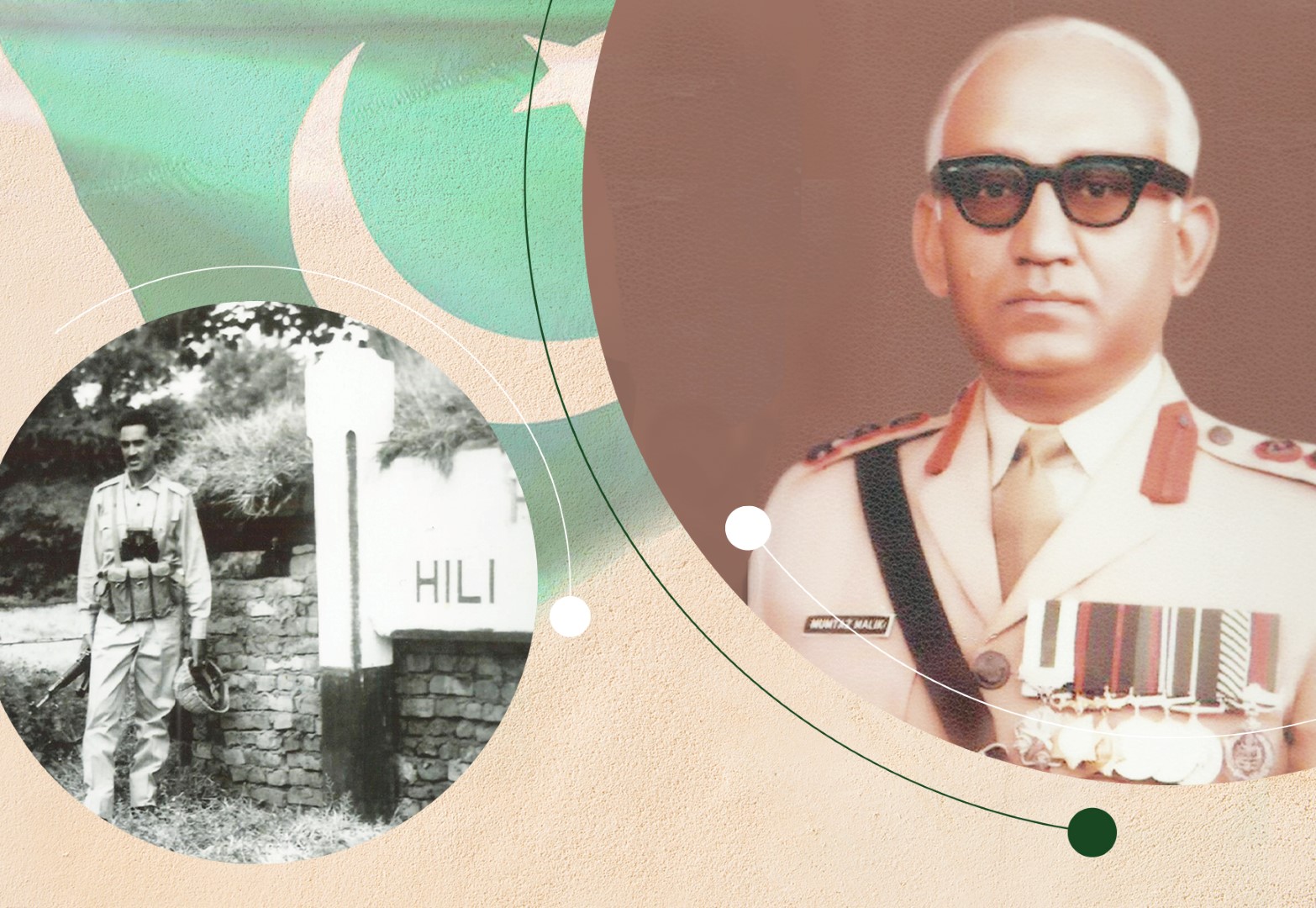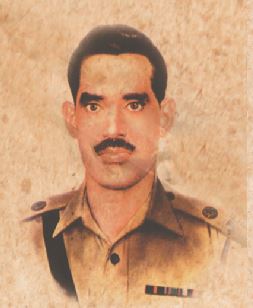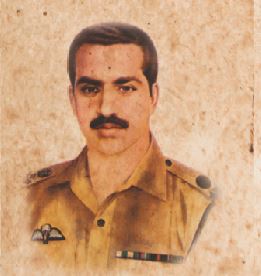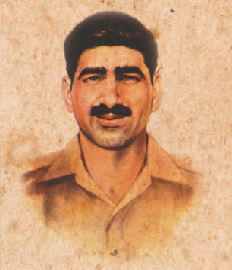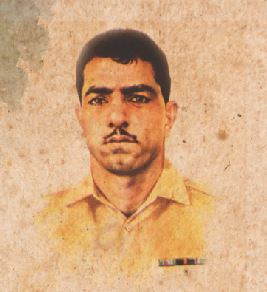From the Desk to the Battlefield
The fighting tale of a staff officer who fought and led his battalion at the famous Hilli Sector, East Pakistan, during the 1971 War.
One finds a rare parallel precedence where a serving staff officer left his desk job to command a battalion on the battlefront, as was demonstrated by Lt. Col. (later Brig.) Mumtaz Malik, Sitara-e-Jurat (SJ). What moulded this unprecedented episode of the Indo-Pakistan War of 1971 in erstwhile East Pakistan is the kind of story that legends are made of.
4 Frontier Force (FF) was defending the Pakistani territory in Hilli Sector as part of the Eastern Command and had suffered huge casualties. What could be more devastating and abysmal for an officer than receiving the news of his battalion suffering heavy casualties (that included its Commanding Officer, who was wounded and hospitalised). Brig. Mumtaz Malik not only volunteered to command his battalion in the thick of the battlefield but created a history of valor that even the Indians acknowledged wholeheartedly.
When I was writing the book on
Nishan-e-Haiders and wanted to do the write up on Major Akram
shaheed, I had sought counsel from the officers of 4 FF, where Brig. Mumtaz Malik was unanimously recommended by them, especially by Lt. Gen. Chaudhry Sardar Ali.
When I met him in Lahore in 2013, it was my first meeting with this legendary officer.
I found him to be a person of modest demeanour, who spoke little about himself, but lit up when he talked about 4 FF. I found him unique in a way that he was the one who had recommended Major Akram
shaheed for
Nishan-e-Haider as well as the legendary Major Sabir Kamal
shaheed from 13 FF for his second Sitara-e-Jurat. His personality inspired and convinced me to get the foreword written by him for the book – the Nishan-e-Haider.
Situation in Erstwhile East Pakistan – December 1971 War
It was mid-October 1971 that the war clouds started gathering. The Indian Army started amassing formations like dominoes and moved over a dozen squadrons of the Indian Air Force, deployed through a ring of equal number of airbases, against one squadron of Pakistan Air Force (PAF) that could operate from one solitary airbase. The crescendo of the massive build-up by the Indian Armed Forces could be heard far and wide.
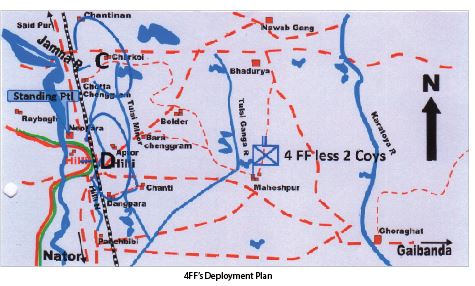
The insurgency caused and spread by the Mukti Bahini had telling effects on the Pakistani forces who, apart from having an eye on their Western border with India, had to be wary of the hidden and more treacherous enemy within. The attacks began to pick up momentum in size as well as frequency.
After the invasion of East Pakistan by India on November 21, 1971 (the day of Eid-ul-Fitr), the undeclared war turned into an open war. Pakistani troops were encircled from all directions, being cut off from West Pakistan, 1000 miles apart. Thus, completely beleaguered, the heavily outnumbered Pakistani troops were fighting the enemy at the front as well as in the rear. Despite such heavy odds, it is a tribute to their valor and determination that they continued to fight with resolution until they were dragged into an unwanted ceasefire. Thousands of our brave men laid down their lives in the defence of Pakistan, while many of them were not even lucky enough to receive a proper burial.
With the Indian build-up for war, the situation in Hilli started changing drastically, with regular Indian troops replacing the Border Security Force along the border and a considerable Indian Army build-up was observed. They started engaging the Pakistani positions with artillery and air more vigorously. It was obvious from the Indian vibes that they were preparing to initiate aggression against Pakistan anytime soon.
Being posted at the Eastern Command Headquarters, Lt. Col. Mumtaz Malik kept a vigil on his battalion 4 FF, and also on its orbat. It was in the same process that he learnt about the high casualty rate of his battalion, that also included the Commanding Officer who was evacuated from the battlefront after being seriously wounded, along with a high count of other ranks. Completely saddened by the news, Lt. Col. Mumtaz Malik pleaded with Lt. Gen. A. A. K. Niazi to allow him to join his battalion on the battlefront, as he felt confident in restoring their morale and leading them into the battle. After a lot of hesitation, Lt. Gen. A. A. K. Niazi permitted him to join his battalion. In the words of Brig. Mumtaz Malik, “I had to literally desert HQ Eastern Command”.
Till his arrival at the battlefield, 4 FF had been ably led by its Commanding Officer, Lt. Col. (later Brig.) Akhlaque Abbasi, who also earned SJ. The battalion had been exposed to repeated attacks, which were bravely repulsed through counterattacks but in the process suffered heavy losses, including the CO and five officers (Major M. Iqbal, Major Julian Peter, Major Mushtaq Ahmed, Captain Sajid Ismail and 2/Lt (later Brig.) M. Saleem).
Significance of Hilli Sector
The border entry point to the village of Hilli was critically located on the main axis of advance of the Indian 33 Corps (Commanded by Lt. Gen. M. L. Thapan) towards their main objective – Bogra (location of Pakistan’s 16 Division HQ). In spite of the full might of the beefed-up and fresh Indian 20 Mountain Division (Commanded by Maj. Gen. Lachhman Singh Lehl) supported by 33 Corps Artillery, Army Aviation and IAF desperately kept attacking 4 FF positions repeatedly and with fresh troops but they could not gain even an inch of the land despite their best efforts from November
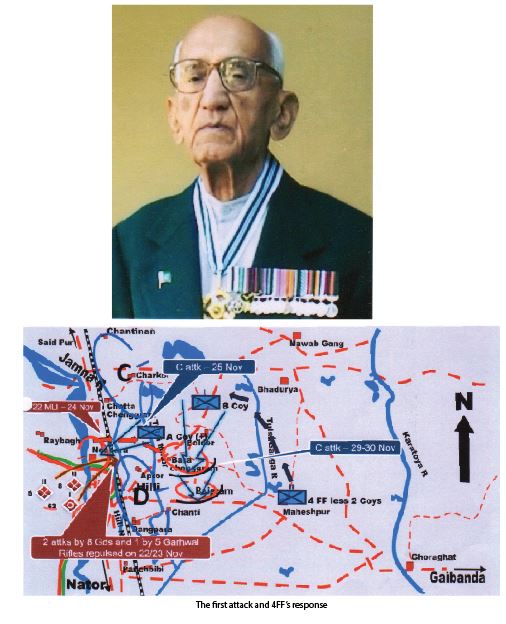
21 till December 11, 1971. Later on, the Indians, in sheer desperation, gave up their fight against Hilli and were ordered to bypass Hilli through the inter-brigade gap towards the north of Hilli. It was only then that 4 FF was ordered to pull back and take up positions on the next defensive line in Mahastan area, ahead of Bogra.
Conduct of the Battle
The battle unfolded on November 21, 1971 at about midday with Indian artillery pounding the Pakistani positions which continued throughout the night – a prelude to a major Indian attack in this area. The shelling caused extensive damage to the line of communication of the Pakistani defences, especially within 4 FF’s positions. From the night of November 22/23 onwards, the Indians attacked three times. The herculean defensive efforts of 4 FF broke the thrust of the enemy attacks and beat them back.
4 FF’s Counterattack
The brave Commanding Officer, Lt. Col. (later Brigadier) Akhlaque Abbasi, SJ, along with the Battery Commander, Major Anwar, positioned himself with the forward company. The attacking force succeeded in capturing some villages but the resolute fight put up by 4 FF stopped their progress further. The battalion, particularly the forward company, suffered casualties that included severe injuries to the Commanding Officer, Company Commander Major Muhammad Iqbal and the Battery Commander, who were evacuated from the battlefront.
Change of Command
Lt. Col. Akhlaque Abbasi remained at the Main Dressing Station (MDS) at Bogra from the afternoon of November 26 till the morning of December 7 1971, when he again reassumed the command. During his absence, Lt. Col. Muhammad Mumtaz Malik commanded 4 FF. These two brave leaders of unequalled prowess inspired their men to deeds of heroism through personal example by leading from the front, leaving a legacy for the future leaders. The enemy, after having resorted to aerial attacks on the defensive positions, carried out ground attacks supported by tanks and artillery. The battalion not only halted the enemy attack but also forced it to withdraw in frustration.
Battle of Roybhag
The Indian 202 Brigade attacked this position four times on December 4-5, and all these attacks were mainly directed against the left forward platoon, with the support of a squadron of tanks spearheading each attack of the enemy, virtually turning the defences into a pulp. Intense artillery barrages pulverized the defensive area into a mass of thick smoke and dust. It was during this battle that Major Muhammad Akram, while leading from the front, stood like a rock despite the enemy’s overwhelming superiority. The morale of this battalion was so high that they destroyed or damaged a large number of Indian tanks and inflicted heavy casualties on the attacker.
Major Muhammad Akram acted beyond the known limits of courage and sacrifice and created history. With incredible precision, he himself destroyed three tanks which drove a chink and dread in the Indian armour. In the process of adjusting the aiming sight on the fourth tank, the smoke cleared and an enemy tank spotted him and fired its .50 browning, shooting through his throat. Akram’s last words were “Hold out till last”.
 Change of Command and the Subsequent Role of Lt. Col. Mumtaz Malik
Change of Command and the Subsequent Role of Lt. Col. Mumtaz Malik
Lt. Col. Abbasi resumed the battalion’s command from Lt. Col. Mumtaz Malik on December 7. On the same day, the GOC and Brigade Commander, during their visit, were ambushed by Indian troops at Pirganj. On being relieved by Lt. Col. Abbasi, Lt. Col. Mumtaz happened to be the seniormost Lt. Col. on the battlefront and was ordered to take over 205 Brigade. Not only did he command his own battalion during the battle, but also commanded the brigade for three days during the critical stages of the Battle of Hilli and Bhaduria. Brigadier Tajamal returned on December 9, 1971.
On the night of December 8/9, Indians launched a surprise attack and gained a small foothold at Baigram while suffering heavy casualties. Lt. Col. Mumtaz Malik, having been on the battlefront and taking advantage of being in the battle picture, got his act together. Beginning with the creation of a Brigade Reserve built round a company of 13 FF (under Major Sabir Kamal) and a company of 8 Baloch (under Major Mujtaba Hassan) deployed them at Bhaduria. On the morning of December 8, the company of 13 FF was located as the left forward company based on Tulsi-Ganga and company of 8 Baloch as the right forward company based around the built-up area of Bhaduria. Contact was established by evening, even before their positions were ready. This task force was placed under the direct command of Headquarters 205 Brigade and was assigned to act as the Brigade flank guard.
Withdrawal Orders
Maj. Gen. Lachhman Singh, whose 20 Mountain Division was pitched against 4 Frontier Force at Hilli, writes in his book titled
Victory in Bangladesh:
“Throughout the early hours of November 24, 1971, the fight continued from bunker to bunker, pond to pond and from trench to trench. At this stage 8 Guard had suffered heavily and was running low on ammunition.
As first light approached (November 24, 1971), it was clear that 8 Guards had not been able to clear Morapara (Aptor). Small groups under gallant officers of both sides indulged in attacks and counterattacks throughout the night. It was a ruthless determination to exterminate the other side. Finally, the Pakistanis managed to retain most of the objective area except for a small pocket under Captain Sharma.
This battle showed the determination and great fighting potential of Indian and Pakistani soldiers. In Hilli, they proved to be worthy foes”.
General Palit wrote about the first encounter at Hilli in his article captioned
Lightening Campaign, “This battle, which lasted three days, constituted the heaviest fighting to date”.
Major Jodh Singh, in his book
Indira’s India says, “It was felt that if the Hilli defence had been bypassed earlier – unnecessary heavy losses could have been avoided by our troops”.
In an article published in
The Illustrated Weekly of India, dated December 23 1973, under the caption Untold Inside Story, by Lt. Gen. J. S. Aurora, the author writes: “20 Mountain Division opened their main thrust by attacking Hilli, where we encountered very stiff and determined resistance.
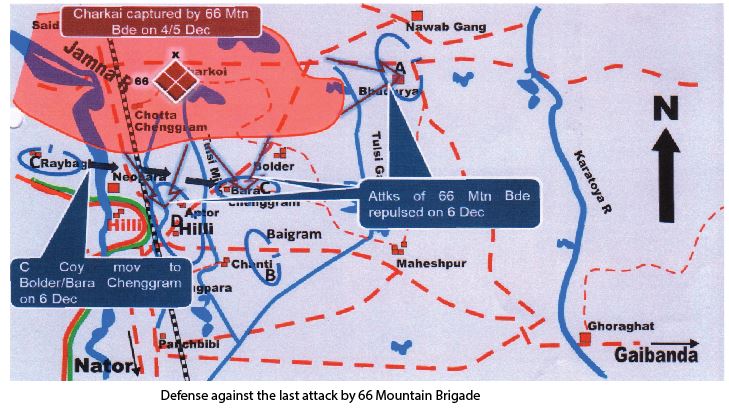
The initial attack was spearheaded by 8 Guards who fought valiantly and in spite of very heavy causalities and repeated counterattacks, the enemy did not give up”.
A few reflections upon the Battle of Hilli by Maj. Gen. Tajamal Hussain Malik (R), who commanded 205 Brigade in Hilli, in his book
The Story of My Struggle, recalls the battle in the following words:
“By the time an all-out war was declared on December 3, 1971, the battle of Hilli had already gone on for the past ten days and 20 Mountain Division had throughout encountered bitter resistance and suffered heavy casualties.
On the morning of December 6, 1971, 66 Indian Brigade tried to link up with the rest of 20 Mountain Division still fighting in front of our Hilli positions. Here again they failed because 4 Frontier Force companies stood like a rock to bar their way.
Having fought a bloody battle for 19 days from night 23rd/24th November to 11th December at Hilli, I felt emotionally attached to Hilli positions. I was, therefore, reluctant to abandon that position. However, in view of a changed situation, I agreed to pull back 4 Frontier Force from Hilli to area Khetlal.
By about mid-day on December 12, while I was standing near the road at Mahastan position, 4 FF arrived from Hilli. I rushed up to congratulate them on their magnificent performance. I was so overwhelmed that ignoring the military protocol, I kissed the Commanding Officer, Lt. Col. Abbasi, on his cheeks, like one meets a younger brother or son and said to him, ‘I am proud of you’. They had fought a classic battle at Hilli for 19 days and during that period, they had created such awe for the enemy that even when they were finally withdrawing on my orders, the enemy dared not come near them”.
When Brigadier Tajamal learnt that 4 FF had reached Bogra, he remarked, “I have no worries now. I will convert Bogra into a fortress like the one made at Hilli”.
During these 19 days of Battle of Hilli, all 108 ranks of 4 FF laid down their lives in the call of duty and another 162 were wounded. The gallant deeds of our fallen heroes have received glowing tributes from friends and foes alike. Besides the Nishan-e-Haider awarded to Major Muhammad Akram
shaheed, the conferment of 5 SJs and numerous other awards to the valiant sons of the battalion is a true manifestation of the unit’s gallantry in the face of heaviest odds and geopolitical environment.
‘The Sultan of Lieutenant Colonels’
Lt. Col. Raja Sultan Mahmood, Shaheed
The story of a fearless officer of Pakistan Army who ran into an Indian ambush while leading 32 Baloch, and was martyred in a heroic hand-to-hand fight with the enemy.
“I learned that courage was not the absence of fear, but the triumph over it. The brave man is not he who does not feel afraid, but he who conquers that fear.”
–
Nelson Mandela
Pakistan Army’s leadership has been blessed to have the finest officers, who have given this army a place amongst the best armies of the world. Obedience of command and carrying out orders is ingrained amongst the officers from the time they are nurtured at the Military Academy and continue to mature as they grow in rank, service and stature. Plans are discussed, debated and modified. Alternative plans are crafted and presented by tactical commanders to cater for any unintended outcome. Yet, as the military tradition goes, units obey the final command, irrespective of the consequences without further questioning the rationale. There have been incidences in our battle history, but in very rare and exceptional situations, where certain officers asked for alternative plans or delays once they felt strongly that in carrying out those orders they would not only endanger the lives of those under their command, but also their mission. In most of these cases, once those officers accepted the orders, they not only carried them out to the peril of their lives but also to the best of their abilities, keeping the good order of military discipline foremost. They also led from the front and led by example; in the process most of them gave the supreme sacrifice and embraced
shahadat. Their actions in majority of the cases were not only applauded by all and sundry but were acknowledged more vociferously by the enemy, who could not resist acknowledging those actions in their books.
I have been able to list out a few individuals, who stand tall in making such sacrifices, carrying out heroic deeds, the likes of which our coming generations can emulate and learn lessons from. The long list includes heroes like Lt. Col. Raja Akram
shaheed (HJ), CO 35 FF; Lt. Col. Ghulam Hussain shaheed (HJ), CO 3 Punjab; Major Mohammad Akram
shaheed, (NH) 4 FF; Major Shabir Sharif
shaheed, (NH), (SJ) 6 FF and Lt. Col. Raja Sultan Mahmood,
shaheed.
To cover all of them in one article would make the reader lose his attention span, therefore I have selected one such unsung hero, which is Lt. Col. Raja Sultan Mahmood,
shaheed.
Early Life and Military Career
Raja Sultan Mahmood
shaheed was born on March 14, 1931. He completed his college education from Gordon College. He joined PMA with the 9th PMA Long Course on March 26, 1952 and passed out on March 12, 1954. On commissioning he joined the School of Infantry on March 13, 1954. His brief career details are as under:
• 15 Baloch: June 9, 1956
• MI Directorate, GHQ: December 9, 1959
• Staff Course: 1966
• 15 Baloch: April 11, 1966
• BM: March 26, 1968
• 22 Baloch: March 10, 1971
• 32 Baloch: October 11, 1971
• Embraced
shahadat: December 8, 1971
Originally from 15 Baloch, Lt. Col. Sultan was leading 32 Baloch in erstwhile East Pakistan during the Indo-Pakistan War of 1971 in the Bogra Sector at a place called Pirganj, located 65 kilometers north of Bogra.
Days Prior to Indo-Pakistan War of 1971, Leading Up to His Shahadat
On his promotion from BM 1 AK Brigade to Commanding Officer 22 Baloch, Lt. Col. Sultan Mahmood drove with his family from Azad Kashmir to Quetta on a Volkswagen model 1966 (Registration number, LEG 1970). The whole family arrived on March 10 and after settling the family down, he left for East Pakistan to assume the command of 22 Baloch. The family was tucked in on 5 Zamzama Road before his departure.
Lt. Col. Raja Sultan Mahmood reported to Quetta in late 1970 where he took over the command of 22 Baloch, which was a part of 16 Infantry Division. In March 1971, 16 Infantry Division was ordered to move to East Pakistan. This herculean effort was carried out through a massive airlift in a record time of six days. Upon arrival in East Pakistan, he tried to get his battalion settled and prepared for its new operational role in a totally changed environment. It was a test case for commanders at all levels as an insurgency had already been perpetrated by Mukti Bahini, who were morally and materially supported by the Indians.
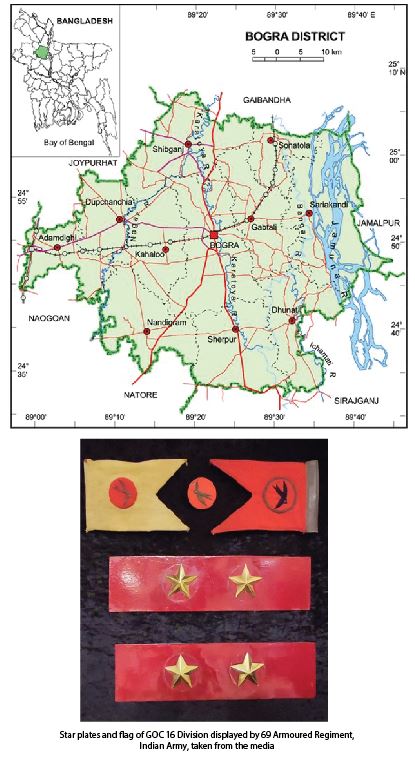
It was in those troubled times when everyone’s nerves were being tested and patience was running out that Lt. Col. Sultan, during one of the professional discussions with his General Officer Commanding (GOC) Major General Qazi Majeed over an impending operation, disagreed with him and recommended an alternative plan to carry out the same mission with a little more time for preparations. Whereas the GOC desired to launch 22 Baloch urgently into an operation which looked suicidal to Lt. Col. Sultan as that could incur huge losses and even jeopardize the mission. The GOC took exception to his views and ordered him to report to Headquarters Eastern Command for further orders. However, 22 Baloch was sent into the operation with the same plan under the Second-in-Command (2IC), but suffered huge casualties. (This fact has been confirmed by Colonel Tahir Kardar, who was the Intelligence Officer of 22 Baloch at that time).
Lt. Col. Raja Sultan Mahmood reported to Headquarters Eastern Command, from where he was reassigned to take over the command of 32 Baloch operating under 205 Brigade, commanded by Brig. Tajammul Hussain Malik.
On taking over the command, Lt. Col. Sultan found himself in a similar situation as he did in his earlier formation. He was getting acquainted with the troops as well as the area that his GOC and Brigade Commander were reported to be ambushed by Muktis/Indians and an urgent operation was planned to rescue them and restore the situation. 32 Baloch received orders from Headquaters 16 Division that their GOC, Maj. Gen. Nazar Hussain Shah had been ambushed/cordoned by the Mukti Bahini at Pirganj on the Bogra-Rangpur Road.
Lt. Col. Sultan visited Division Headquarters for necessary briefing/situation update. On his arrival back, he ordered his battalion to get ready for the task. It was a pitch dark night and he started the advance by leading from the front. It was during this move to the operational area that he ran into an Indian ambush while leading 32 Baloch. A hand-to-hand fight ensued. Lt. Col. Raja Sultan Mahmood, along with 60 soldiers, went missing on December 8, 1971, and it was later reported that he had embraced martyrdom.
It was later revealed by eyewitnesses that Lt. Col. Sultan Mahmood embraced martyrdom when his battalion was ambushed during the pitch dark night, and during this process he took many bullets in his chest. Incongruously, the brave Commanding Officer’s body was never recovered. As the legend goes, his body was buried by the Indians. The same was confirmed by various indian newspapers and books written by Indian officers.
Lt. Col. Raja Sultan Mahmood
shaheed’s gallantry was acknowledged by the opposing Indian commanders and also acknowledged in the following words in Indian newspapers:
“During the Bangladesh liberation war, (1971) one intrepid Pakistani officer leading a bayonet charged into the guts of 2/5 GR (FF), was slashed with kukri (knife) by an equally brave officer Captain Jatandar Nath Sood (who was awarded Vir Chakra posthumously). The Pakistani officer’s body and identity was completely smeared with blood and he was mistaken for Brig Tajjamul Hussain Malik, Commander of 205 Pakistan Infantry Brigade. It was at his funeral that the documents found with him as well as his blood soaked epaulettes correctly identified him as PA-4863, Lt Col Raja Sultan Mahmood, CO of Baloch Regiment. As his body was lowered into the grave, one Gurkha JCO threw in Sultan’s badges of rank, looked up towards the heaven and muttered, “Let him also know this Sultan Bahadur was a Lt Col, who is called by all friends and foes as “Sultan of Lieutenant Colonels.” In this action the CO died a heroic death in a hand to hand fight with the enemy. 60 soldiers were also lost in this action. His valor was also recognized by the Indians.”
(The Hindu)
“Old day’s hand to hand fight’s memories come to mind, where one CO of one of the Baloch Regiments of Pakistan Army had a hand to hand fight with an Indian Captain. The Lt Col got martyrdom on the spot whereas the Indian Captain died later in the hospital, who could not bear the wounds slashed by the Pakistani Col. The Col was equipped with a pistol and the Indian Captain with a sten gun. An Indian JCO remembered him as Sultan of Kings and King of Sultans.”
(The Statesman)
The Nishan-e-Haider Recipients of 1971 War
Accounts of the extraordinarily brave men of Pakistan Armed Forces who were awarded the highest military gallantry award of Pakistan.
Major Muhammad Akram shaheed (September 25, 1941-December 5, 1971)
In 1971, the situation in East Pakistan was getting worse as the Indian troops were consistently penetrating inside East Pakistan’s borders and were sponsoring an insurgency through the indigenous terrorist organization, Mukti Bahini, to destabilise East Pakistan. It was not long after that an all-out war started in December 1971. The main objective of the Indian Army was to get control of Bogra, thereby cutting off Pakistani forces in the north from the rest of East Pakistan. The best way of getting to Bogra was through the town of Hilli. The frontal assault on Pakistan’s fortifications took a huge toll on the Indian Army. In a renewed effort and further strengthening, the 20th Indian Mountain Division, with a strength of 20,000 men, led by Major General Lachhman Singh, comprising 66 Brigade, 165 Brigade, 202 Brigade, and 340 Brigade (all infantry units), 3 Armoured Brigade, 471 Engineer Brigade, and two artillery brigades augmented by 33 Corps Artillery attacked Hilli Sector.
The ground troops were aided by aerial support provided by the Indian Air Force, which had already acquired total air superiority in the East and were armed with rockets, guns, and 1000 lbs bombs. On Pakistan’s side, the area of responsibility was with 205 Brigade, led by Brigadier (later Major General) Tajammul Hussain Malik. 205 Brigade had deployed 4 FF, 13 FF, and 8 Baloch Regiments. Major Akram was commanding Charlie Company of 4 FF Regiment in the forward most localities of the Hilli Sector. This Company position was very vital and had blocked the enemy's route of advance. His Company came under continuous Indian Army attacks duly supported by the Indian Air Force, heavy artillery, and armour. Charlie Company, commanded by Major Muhammad Akram, put up a heroic resistance that earned praise even from the Indians.
He, along with his brave Company, stood like a rock between the Indian forces and Pakistani positions for over two weeks, despite the Indians outnumbering them in manpower, firepower, and total air superiority, putting even helicopters and aircraft to best use.
Major Muhammad Akram and his men repulsed every successive attack, inflicting heavy casualties on the Indians. This battle was unique as it had begun before the official declaration of the Indo-Pak War and continued even after the formal surrender of troops at Dacca. The Indians, on several occasions, used megaphones and shouted at his company, asking him to surrender but Major Akram refused. However, the sense of sacrifice, valor, and chivalry was at its apex for the men of this Company, but their source of strength remained embodied in the personality of Major Muhammad Akram, whose confident voice and firm orders to deal with the ever-changing situation gave him a stature of force that raged even fiercer than any battalion. His conduct and resolve incessantly generated high spirit for all his subordinates. Each attack of the enemy on that day was repulsed. By the evening of December 5, the enemy was only engaging the positions of Charlie Company with tanks and artillery fire.
It was such a deafening and shattering holocaust of fire and fury, which had been constantly raging for about three days and the steadily weakening strength of the company was pulling on to the hastily prepared defensive positions. Major Akram was personally conducting the battle from the forward defended locality. The need to solve the nuisance of tank fire became the need of the hour. At this juncture, the moment arrived which became a classic example of the highest sense of leadership, commitment and heroism. Major Muhammad Akram acted beyond the known limits of sacrifice and rose up to create history.
Carrying a 40 mm Chinese rocket launcher, he crawled along with his runner right up to the clump where enemy tanks were positioned and sited himself at a distance of almost 100 meters from them. From this position, he engaged these tanks. With incredible precision, he destroyed three tanks. It created an immense dread in the armour column of the enemy. While adjusting the aiming sight on the fourth tank the smoke got cleared and an enemy tank spotted him, quickly opening fire with its .50 browning. He was shot through his neck. Akram’s last words were, “Hold out until last”. The bravest son of the platoon graced the ground as a paragon of gallantry and heroism. Even after the shahadat of their Company Commander, Charlie Company was able to hold on to its positions and foiled the Indian attempts to gain foothold nor were they allowed to maintain the momentum in their attacks.
For his outstanding bravery, he was awarded with Nishan-e-Haider, posthumously.
Major Shabbir Sharif shaheed (April 28, 1943-December 6, 1971)
In the 1971 War, at the outbreak of hostilities, a pre-emptive operation was launched to capture the Sabuna Bund in order to give greater depth and protection to the Sulaimanki Headworks. Major Shabbir not only captured that with lightning speed but held his position against all odds.
During the war, a company commander from India, Major Narain Singh, had sworn before going on attack that he would either retake the bridge or would never return. Narain Singh was also interested in defeating Shabbir Sharif as for the last two days he had been hearing from his own men that the Pakistani side had a very tough commander with them. While the battle was going on, Narain Singh, with a few men, came very close to Shabbir’s position. "Where is Shabbir Sharif?," he called out, "If he has the courage, he should come out right now and face me like a man". Shabbir Sharif, being as hot-headed as Singh, left his position and jumped in front of him upon the call. Perhaps Narain Singh could not make out that it was Shabbir Sharif, as it was very dark, and lobbed a grenade in his direction. The grenade exploded a few feet away from Shabbir and his shirt caught fire. A hand-to-hand combat followed between Sharif and Singh. After a short struggle, Shabbir managed to throw Singh on the ground and put his knee on his chest. Taking the sten gun from his hand, he emptied it on Singh's chest. While the Pakistani soldiers came to Sharif to check whether he was all right, those accompanying Singh disappeared in the darkness.
The ferocious non-stop battle of December 4, 5, and 6 was an amazing feat of valor and sacrifice led by the Company Commander, Major Shabbir. At around 1100 hours on December 6, the Indians launched yet another major counter-attack with tanks, preceded by an airstrike and heavy artillery fire. Major Shabbir started firing on the Indian tanks with 106 mm recoilless rifle. While he was engaged in targeting the enemy tanks, one of the enemy tanks fired with its main gun at him, which proved fatal. Major Shabbir gave his life leading from the front and fighting until the last minute. Here was a brave man whose mere presence was a guarantee of victory. He had said this before the war, “If war breaks out this time, I will not be a witness to the ceasefire”.
It is worth mentioning that this operation by 6 FF was so humiliating for the Indians that in 12 days they changed their General Officer Commanding and Brigade Commanders thrice in this sector.
He was decorated with Nishan-e-Haider for his bravery and deeds of valor.
Sowar Muhammad Hussain shaheed (June 18, 1949-December 10, 1971)
When the war broke out in 1971, Sowar Muhammad Hussain took an active part in every battle which his unit was engaged in, unmindful of any danger no matter how grave the situation was. Despite his trade being a driver, he always yearned to participate in active battle.
Sowar Muhammad Hussain was performing the duties as the driver of a Dodge truck in a squadron of 20 Lancers. On December 5, 1971, while braving intense shelling and direct fire from enemy tanks and infantry, he went from trench to trench, delivering ammunition to the 106 mm recoilless rifle crews who were engaging the Indian tanks on the frontline. It was then that his vehicle got a direct hit by Indian artillery shelling.
Since his vehicle had been knocked out, he was assigned a new responsibility of spotting Indian tanks and then help engaging them by the 106 mm recoilless rifles. He carried out this duty most brilliantly and was able to locate even well camouflaged tanks of the Indian Army. In order to do so, at times he had to stay out in the open, changing his position to know the location of the Indian tanks. Through his correct target indication, own recoilless rifles were able to hit Indian tanks to good effect. On the following day, he went out with four fighting patrols and undertook the most hazardous mission.
On December 10, 1971, he spotted the Indians digging in all along a minefield laid out by Pakistan Army near the Harar Khurd village. He immediately informed the second-in-command of his unit. While having reported about this development, he, on his own initiative, directed accurate fire at the enemy resulting in the destruction of enemy tanks. In the process, he was hit in the chest by a burst of machine gun fire and embraced
shahadat.
At the time of
shahadat, he was just 22 years old. Sowar Muhammad Hussain has the distinction of being the first among the soldier cadre of Pakistan Army to be awarded with Nishan-e-Haider for his unmatchable courage and gallant war performance.
20 Lancers has since been given the honor of being called 20 Lancers (Haidari) due to brave Sowar Muhammad Hussain’s actions, thus making his regiment the only armour regiment that has been awarded with Nishan-e-Haider.
Lance Naik Muhammad Mahfuz shaheed (October 25, 1944-December 17, 1971)
When the war broke out in 1971, Lance Naik Muhammad Mahfuz was deployed on the Wagah-Attari Sector with Alpha Company of 15 Punjab Regiment. His company was ordered to carry out an attack on the village of Pul Kanjri from where the Indian Army had been exerting immense pressure on the Pakistani troops facing them. This Indian position was quite close from the defended positions of the Pakistani troops but was very heavily held by the Indians. As part of his Company’s attack, he was deputed by his Company Commander to form part of the firebase and support the attack by manning the light machine gun (LMG). Therefore, he was part of the detachment that covered the move of the assaulting troops’ leading wave. As the attack progressed, his detachment moved forward with the assaulting troops as well, until they were caught up in the crossfire. This crossfire was incessant, and that too combined with all calibres of artillery shelling. His detachment kept creeping up and during this act, his companion firing the LMG embraced
shahadat.
He got hold of this LMG and started firing at the Indians with renewed vigor and motivation, inflicting heavy casualties on them. While he was engaging the Indians, a direct enemy shell destroyed his LMG. This did not stop young Mahfuz. He had seen an enemy bunker whose automatic fire had inflicted heavy casualties on his comrades. By using his best training in the art of field craft, he closed up with the enemy position, going straight for the LMG position. While he was closing up, both of his legs were injured badly by shell splinters and bullets; he was totally incapacitated and, therefore, pinned down, unable to even walk.
Lying face down, he kept observing the battle scene and decided to go for a bunker that housed the Indian LMG. Hardly fit for walking or even moving, he still gathered all his energy and resolve to go for it at any cost to avenge his fallen comrades and complete the mission of his Company. By stealthily crawling initially, he managed to close up with the LMG bunker and somehow was able to get around the rear entrance limpingly, while the Indian detachment was engaging the advancing Pakistani attacking forces. He managed to muster up all his strength and not only pounced on the firer but he went for his neck and strangled him to death with his bare hands. Meanwhile, the other crew member, who was watching the grappling match, managed to bayonet him and got him fatally wounded. He fell down more or less unconscious by now.
His brave action resulted in the capture of the Indian position in a miraculous attack and remains one of the finest actions at tactical levels in the history of Pakistan Army. The attacking troops managed to capture this formidable position by sheer dint of the courage of Mahfuz
shaheed.
After the 1971 War, when the flag meetings took place, the Indian Army Commander conveyed to the Pakistani Commander that he had been in many actions in wars and real life, but he never came across someone as brave as Mahfuz
shaheed.
Former Army Chief, General Tikka Khan said these words in praise of Muhammad Mahfuz
shaheed, “The
shaheed has set an unprecedented example for emulating by all men of Pakistan Army. The whole nation and Pakistan Army is proud of his bravery and actions”.
The writer is a military historian and biographer.
E-mail:
[email protected]




